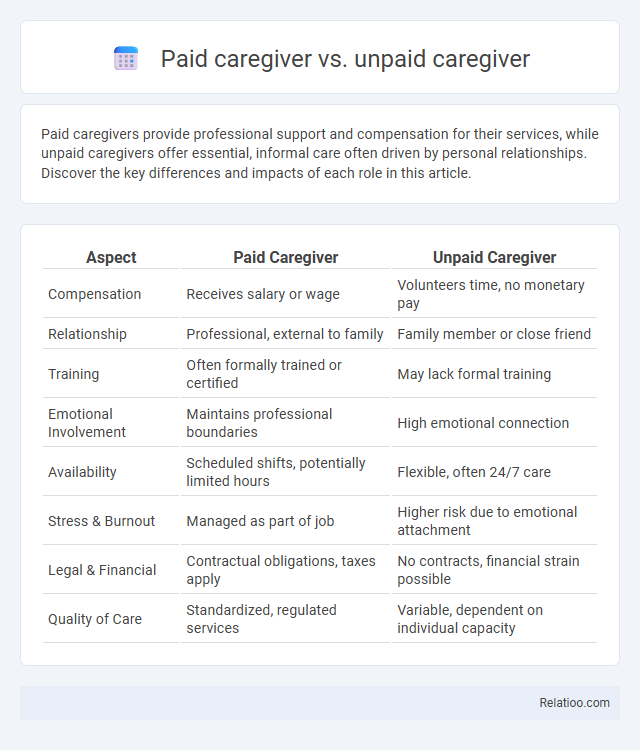Paid caregivers provide professional support and compensation for their services, while unpaid caregivers offer essential, informal care often driven by personal relationships. Discover the key differences and impacts of each role in this article.
Table of Comparison
| Aspect | Paid Caregiver | Unpaid Caregiver |
|---|---|---|
| Compensation | Receives salary or wage | Volunteers time, no monetary pay |
| Relationship | Professional, external to family | Family member or close friend |
| Training | Often formally trained or certified | May lack formal training |
| Emotional Involvement | Maintains professional boundaries | High emotional connection |
| Availability | Scheduled shifts, potentially limited hours | Flexible, often 24/7 care |
| Stress & Burnout | Managed as part of job | Higher risk due to emotional attachment |
| Legal & Financial | Contractual obligations, taxes apply | No contracts, financial strain possible |
| Quality of Care | Standardized, regulated services | Variable, dependent on individual capacity |
Introduction to Paid and Unpaid Caregivers
Paid caregivers provide professional services such as medical support and daily living assistance in exchange for compensation, playing a crucial role in formal healthcare settings. Unpaid caregivers, often family members or friends, offer essential emotional and physical support without financial reimbursement, significantly impacting the well-being of individuals with chronic illness or disabilities. Understanding the differences between paid and unpaid caregivers helps you navigate caregiving options and access appropriate resources tailored to your loved one's needs.
Defining the Roles: Paid vs. Unpaid Caregivers
Paid caregivers are professionals compensated for providing medical, personal, or emotional support to individuals with health or daily living needs, often through agencies or direct hire. Unpaid caregivers, typically family members or friends, offer similar support out of personal commitment without financial remuneration, often balancing this role with other responsibilities. Understanding the distinction highlights differences in training, accountability, and legal obligations, with paid caregivers subject to regulatory standards while unpaid caregivers rely on personal knowledge and resources.
Qualifications and Training Requirements
Paid caregivers typically undergo formal training and certification programs such as CPR, first aid, and specific care techniques to meet regulatory standards and ensure professional care quality. Unpaid caregivers, often family members or friends, generally provide care without formal qualifications or training, relying on personal experience and informal guidance. Your choice between paid and unpaid caregiving should consider the level of specialized knowledge needed to safely manage medical tasks and support the care recipient's health.
Financial Implications for Families
Paid caregivers require a significant financial commitment from families, often involving hourly wages, benefits, and potential overtime costs that can strain household budgets. Unpaid caregivers, typically family members, provide care without direct compensation, resulting in hidden economic impacts such as lost wages, reduced work hours, and increased out-of-pocket expenses for medical supplies and transportation. Both paid and unpaid caregiving contribute to the overall financial burden on families, necessitating careful planning and exploration of support programs to mitigate economic strain.
Emotional Impact on Caregivers
Paid caregivers often experience emotional stress due to professional responsibilities and time constraints, while unpaid caregivers face intense emotional burdens from personal attachment and lack of formal support. The emotional impact on unpaid caregivers can include higher levels of anxiety, depression, and caregiver burnout, as they juggle caregiving with personal and financial responsibilities. Caregiving overall significantly affects mental health, necessitating targeted interventions to support both paid and unpaid caregivers' emotional well-being.
Time Commitment and Flexibility
Paid caregivers typically offer structured schedules with defined hours, enabling clear time commitments that can be adjusted through formal agreements. Unpaid caregivers, often family members or friends, provide flexible, around-the-clock assistance but may face unpredictable and extended time demands impacting personal routines. Your choice between paid and unpaid caregiving significantly affects time commitment and flexibility, with paid caregivers allowing for planned support while unpaid caregivers deliver continuous, adaptable care.
Legal and Ethical Considerations
Paid caregivers are bound by formal contracts and labor laws ensuring fair wages, work hours, and professional accountability, while unpaid caregivers, often family members, lack these legal protections and face ethical dilemmas tied to consent and caregiving boundaries. Your decision between paid and unpaid caregiving must consider legal responsibilities such as liability, mandatory reporting of abuse, and adherence to privacy laws within caregiving roles. Ethical considerations include respecting the care recipient's autonomy, managing potential conflicts of interest, and ensuring informed consent is upheld throughout the caregiving process.
Quality of Care and Accountability
Paid caregivers typically provide a higher level of accountability due to formal training, certifications, and adherence to regulatory standards, resulting in more consistent quality of care. Unpaid caregivers, often family members or friends, may offer personalized and emotionally supportive care but face challenges in maintaining standardized care practices and accountability. The overall quality of caregiving depends on factors such as training, resources, and oversight, with paid caregivers generally ensuring greater professional reliability.
Support Systems and Resources Available
Paid caregivers often have access to formal support systems such as professional training, healthcare benefits, and employer-provided resources that enhance the quality of care. Unpaid caregivers, typically family members or friends, may rely on community programs, respite care, and nonprofit organizations for support, though they often face limited access to comprehensive resources. Your caregiving experience can be greatly improved by tapping into available support networks tailored to both paid and unpaid caregivers, ensuring better emotional and practical assistance.
Choosing the Right Caregiver Option
Choosing the right caregiver option depends on your specific needs, budget, and level of support required. Paid caregivers offer professional, consistent care with trained expertise, while unpaid caregivers, often family members or friends, provide emotional support and cost savings but may lack formal training. Evaluating the balance between affordability, quality of care, and emotional connection helps you select the most suitable caregiving solution.

Infographic: Paid caregiver vs unpaid caregiver
 relatioo.com
relatioo.com